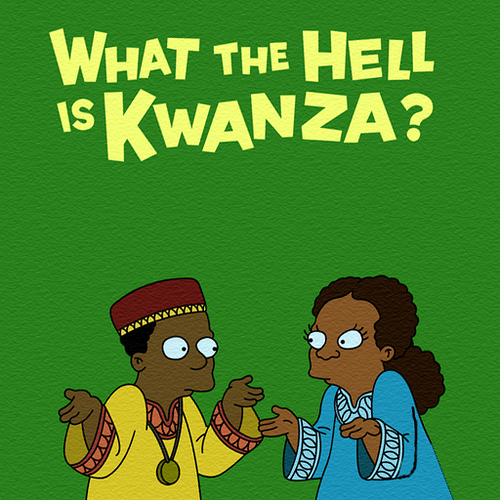Statement by the President and First Lady on Kwanzaa
The White House:
Michelle and I send our warmest wishes to all those celebrating Kwanzaa this holiday season. Today marks the beginning of the week-long celebration honoring African American heritage and culture through the seven principles of Kwanzaa -- unity, self determination, collective work and responsibility, cooperative economics, purpose, creativity, and faith.
Ain't that precious?

Many of you may not know who Kwanza founder Maulana Karenga is: (from wiki)
In 1971, Karenga was sentenced to one to ten years in prison on counts of felonious assault and false imprisonment. One of the victims gave testimony of how Karenga and other men tortured her and another woman. The woman described having been stripped and beaten with an electrical cord. Karenga's estranged wife, Brenda Lorraine Karenga, testified that she sat on the other womans stomach while another man forced water and detergent into her mouth through a hose.
A May 14, 1971, article in the Los Angeles Times described the testimony of one of the women:
"Deborah Jones, who once was given the Swahili title of an African queen, said she and Gail Davis were whipped with an electrical cord and beaten with a karate baton after being ordered to remove their clothes. She testified that a hot soldering iron was placed in Miss Davis' mouth and placed against Miss Davis' face and that one of her own big toes was tightened in a vise. Karenga, head of US, also put detergent and running hoses in their mouths, she said. They also were hit on the heads with toasters."
Jones and Brenda Karenga testified that Karenga believed the women were conspiring to poison him, which Davis has attributed to a combination of ongoing police pressure and his own drug abuse.
Karenga denied any involvement in the torture, and argued that the prosecution was political in nature.[5][18] He was imprisoned at the California Men's Colony, where he studied and wrote on feminism, Pan-Africanism and other subjects. The US organization fell into disarray during his absence and was disbanded in 1974. After he petitioned several black state officials to support his parole on fair sentencing grounds, it was granted in 1975.
Karenga was also a person of interest in the murder of at least 4 black panthers in a turf fight for the "black studies" program at UCLA.
Now read Barry's statement at the top again.

Kwanzaa - Discover the Networks
Kwanzaa is a week-long festival celebrated mainly in the U.S. from December 26 through January 1 each year. It was established in 1966 by the socialist and black nationalist Maulana Karenga, who promoted the holiday as a black alternative to Christmas. Karenga's idea was to celebrate the end of what he considered the Christmas-season exploitation of African Americans.
According to the official Kwanzaa website, the celebration was originally designed to foster "conditions that would enhance the revolutionary social change for the masses of Black Americans," and to provide a "reassessment, reclaiming, recommitment, remembrance, retrieval, resumption, resurrection and rejuvenation of those principles (Way of Life) utilized by Black Americans' ancestors."
Karenga postulated seven major principles to be emphasized during Kwanzaa, identifying each by its Swahili name:
Unity (Umoja)
Self-Determination (Kujichaguila)
Collective Work and Responsibility (Ujima)
Cooperative Economics (Ujamaa)
Purpose (Nia)
Creativity (Kuumba)
Faith (Imani)
Ironically, these seven principles as a whole mirror precisely the principles that were embraced by the Symbionese Liberation Army, a pro-Marxist, revolutionary terrorist group of the 1970s.
The symbol most identified with Kwanzaa consists of seven colored candles placed in a menorah-like candelabrum. These candles borrow their color scheme from Marcus Garveys old black nationalist ensign. The lone black candle represents the so-called black race. The three red candles evoke images of socialist realism with bloody red banners waving to rally the oppressed for the overthrow of the established order. And the three green candles are meant to recall the splendor of Africa's landscapes.
When Karenga first established Kwanzaa, he and his votaries also crafted a flag of black nationalism and a pledge: "We pledge allegiance to the red, black, and green, our flag, the symbol of our eternal struggle, and to the land we must obtain; one nation of black people, with one G-d of us all, totally united in the struggle, for black love, black freedom, and black self-determination."
The philosophy underlying Kwanzaa is known as Kawaida, a variation of classical Marxism that also includes enmity toward white people. Practitioners of Kawaida believe that one's racial identity "determines life conditions, life chances, and self-understanding" -- just as Marxists identify class as the determining factor of one's life conditions.
The name "Kwanzaa" derives from the Swahili term "matunda yakwanza," or "first fruit," and the festival's trappings, as noted above, all have Swahili names. But Swahili is an East African language, whereas the slaves who were brought to North America came from West Africa. In other words, Swahili has no historical relevance whatsoever for American blacks. Karenga nonetheless elected to build his holiday around Swahili terms because Swahili was the trendy language in the Black Power movement during the 1960s.
[ame=http://www.youtube.com/watch?v=0kV-6qVp98Q]Sesame Street: Kwanzaa - YouTube[/ame]
[ame=http://www.youtube.com/watch?v=0UNk2uxep7Q]Sesame Street: Kwanzaa Dancing With Elmo - YouTube[/ame]




